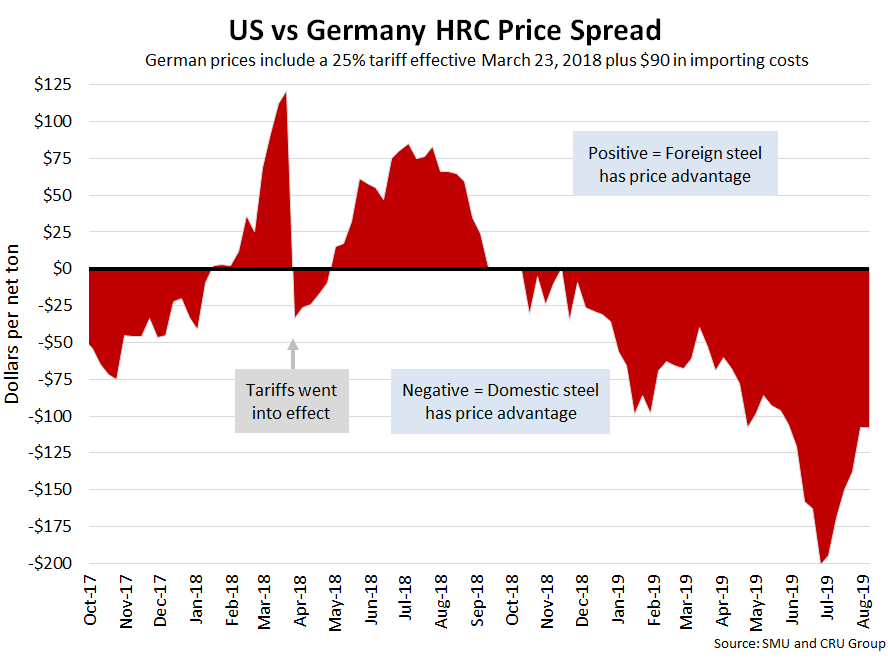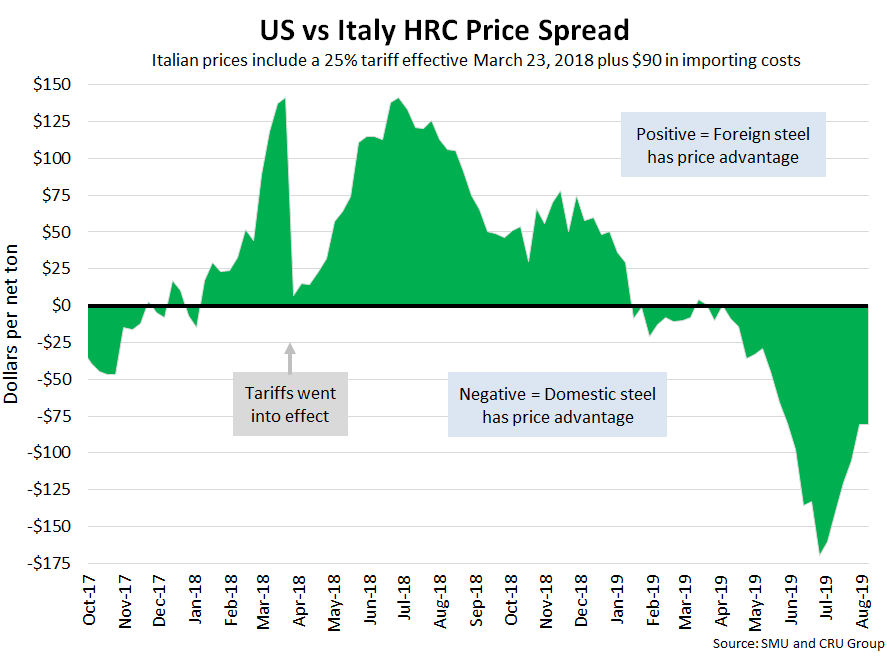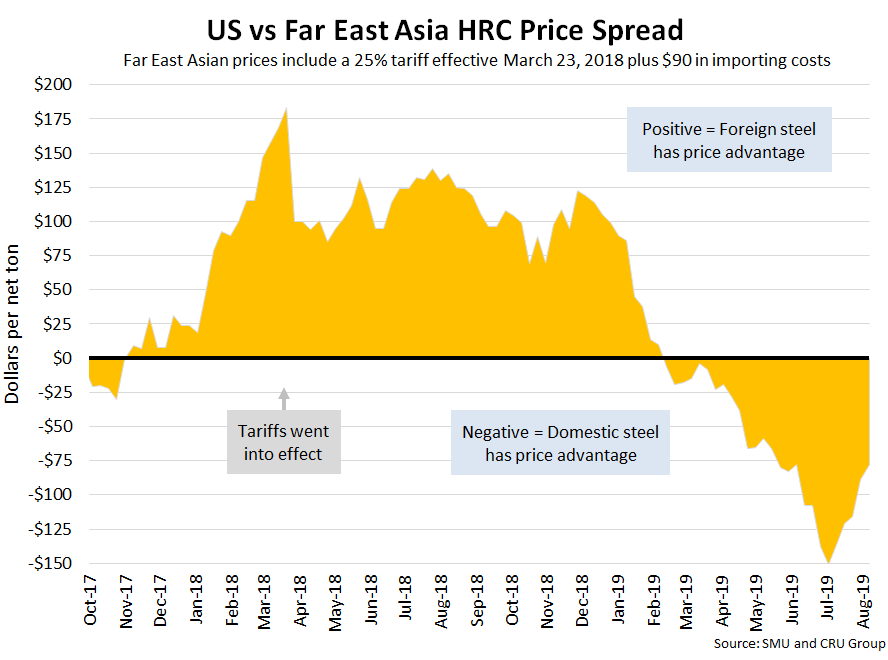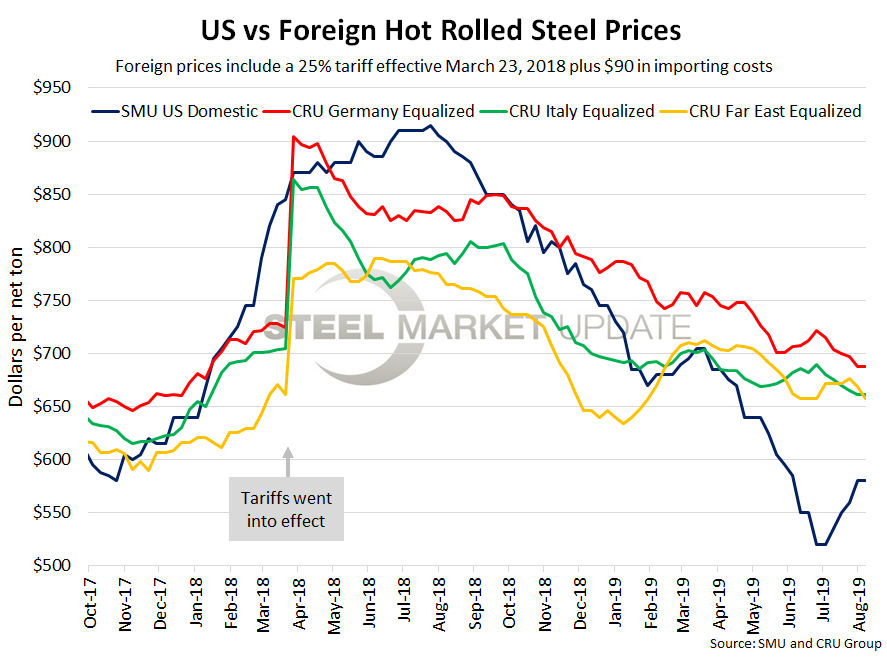International Steel Prices

Foreign vs. Domestic HRC Price: U.S. Still Has Advantage
Written by Brett Linton
August 8, 2019
The following calculation is used by Steel Market Update to identify the theoretical spread between foreign hot rolled steel prices (delivered to U.S. ports) and domestic hot rolled coil prices (FOB domestic mills). We want our readers to be aware that this is only a “theoretical” calculation as freight costs, trader margin and other costs can fluctuate, ultimately influencing the true market spread.
We are comparing the SMU U.S. hot rolled weekly index to CRU hot rolled weekly indices for Germany, Italy and the Far East (East and Southeast Asian port).
![]() SMU now includes a 25 percent import tariff in our foreign vs. domestic price calculations, effective on foreign prices after March 23, 2018. We then add $90 per ton to the foreign prices in consideration of freight costs, handling, trader margin, etc. This provides an approximate “CIF U.S. ports price” that can then be compared against the SMU U.S. hot rolled price. The difference between the domestic and foreign hot rolled prices is then referred to as the “price spread.” As the price spread narrows, the competitiveness of imported steel into the United States is reduced. If the spread widens, then foreign steel becomes more attractive to U.S. flat rolled steel buyers. A positive spread means foreign steel has a price advantage (U.S. prices are higher than foreign prices), while a negative spread means domestic steel has a price advantage (U.S. prices are less than foreign prices). Note that we do not include any anti-dumping (AD) or countervailing duties (CVD) in this analysis.
SMU now includes a 25 percent import tariff in our foreign vs. domestic price calculations, effective on foreign prices after March 23, 2018. We then add $90 per ton to the foreign prices in consideration of freight costs, handling, trader margin, etc. This provides an approximate “CIF U.S. ports price” that can then be compared against the SMU U.S. hot rolled price. The difference between the domestic and foreign hot rolled prices is then referred to as the “price spread.” As the price spread narrows, the competitiveness of imported steel into the United States is reduced. If the spread widens, then foreign steel becomes more attractive to U.S. flat rolled steel buyers. A positive spread means foreign steel has a price advantage (U.S. prices are higher than foreign prices), while a negative spread means domestic steel has a price advantage (U.S. prices are less than foreign prices). Note that we do not include any anti-dumping (AD) or countervailing duties (CVD) in this analysis.
As of Wednesday, Aug. 7, the CRU German HRC price was $478 per net ton, unchanged from the previous week and down $8 from two weeks prior. Adding tariffs and import costs, that puts the price at $688 per ton from Germany delivered to the U.S. The latest Steel Market Update hot rolled price average is $580 per ton for domestic steel, unchanged over last week and up $20 over two weeks ago. The spread between the German and U.S. HR price is now -$108 per ton, unchanged from last week, and up from -$138 two weeks ago. This means domestic hot rolled steel is theoretically $108 per ton cheaper than German steel imported into the U.S. This price spread has remained steady or shrunk each week for the last six weeks. The late-June spread of -$201 was the lowest spread seen in our 7+ year history, and we are now on a 38-week negative spread streak. The four-week average price spread is now -$126 per ton, up $15 from last week and up $37 from two weeks ago.

CRU published Italian HRC prices at $457 per net ton, unchanged over last week and down $3 from two weeks prior. After adding tariffs and import costs, the delivered price of Italian HRC is approximately $661 per ton. Therefore, the spread is now -$81 per ton, unchanged from last week, and up from -$105 two weeks ago. That means domestic sourced steel is theoretically now $81 per ton cheaper than importing Italian HRC into the U.S. This is the 20th consecutive week with a zero or negative price spread. This price spread has also remained steady or shrunk each week for the last six weeks, and the late-June spread of -$170 was the lowest in our limited history. The four-week average price spread is now -$97 per ton, up $15 from last week and up $34 from two weeks ago.

The CRU Far East HRC price fell $9 over last week to $454 per net tons, down $15 from two weeks prior. Adding tariffs and import costs, the delivered price of Far East HRC to the U.S. is $658 per ton. The spread is now -$78 per ton, up from -$89 last week, and up from -$116 two weeks ago, meaning domestic hot rolled steel is theoretically now $78 per ton cheaper than steel imported into the U.S. from Far East Asia. We are on a 26-week negative spread streak, which started in mid-February of this year and was the first negative spread since November 2017. The four-week average price spread is now -$101 per ton, up $15 from last week and up $30 from two weeks ago.

The graph below shows all four prices together and points out the effective date of the tariffs. Foreign prices are referred to as “equalized,” meaning they have been adjusted with the tariffs and importing costs for an apples-to-apples comparison against the U.S. price.

Note: Freight is an important part of the final determination on whether to import foreign steel or buy from a domestic mill supplier. Domestic prices are referenced as FOB the producing mill, while foreign prices are FOB the Port (Houston, NOLA, Savannah, Los Angeles, Camden, etc.). Inland freight, from either a domestic mill or from the port, can dramatically impact the competitiveness of both domestic and foreign steel. When considering lead times, a buyer must take into consideration the momentum of pricing both domestically and in the world markets. In most circumstances (but not all), domestic steel will deliver faster than foreign steel ordered on the same day.

Brett Linton
Read more from Brett LintonLatest in International Steel Prices

US and offshore HRC prices tick lower
The threat of tariffs over the past two months has been a springboard for US prices. But the Section 232 reinstatement on March 13 narrowed the domestic premium over imports on a landed basis.

Domestic CRC prices surge ahead of imports
The price spread between stateside-produced CR and imports reached its widest margin in over a year.

US HR prices rising faster than offshore tags
Hot-rolled (HR) coil prices continued to rally in the US this week, quickly outpacing price gains seen abroad. The result: US hot band prices have grown widely more expensive than imports on a landed basis. The premium US HR tags carry over HR prices abroad now stands at a 14-month high. SMU’s average domestic HR […]

US HR price premium over imports widens
Hot-rolled (HR) coil prices were flat in the US this week, while tags in offshore markets were mostly down.

US HR price premium over imports edges up
The price premium between stateside hot band and landed imports widened slightly this week.
